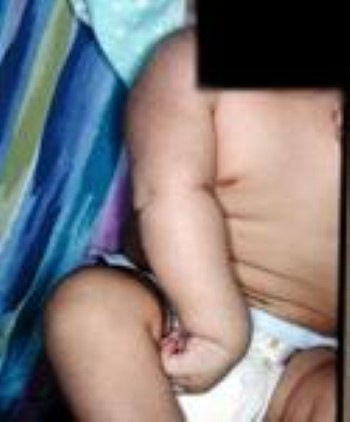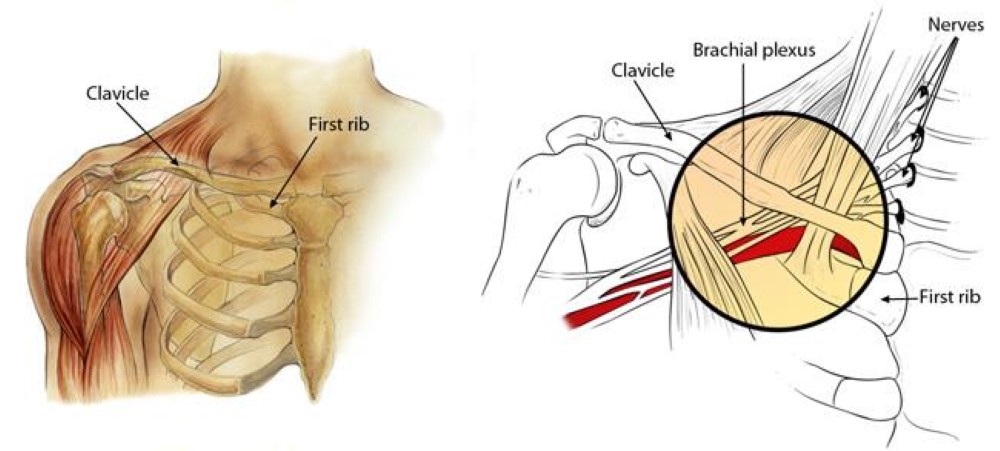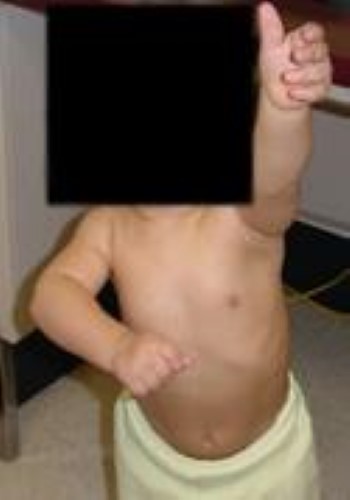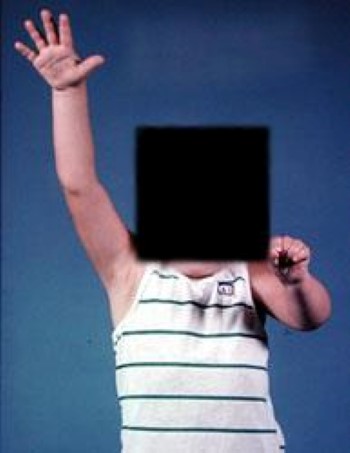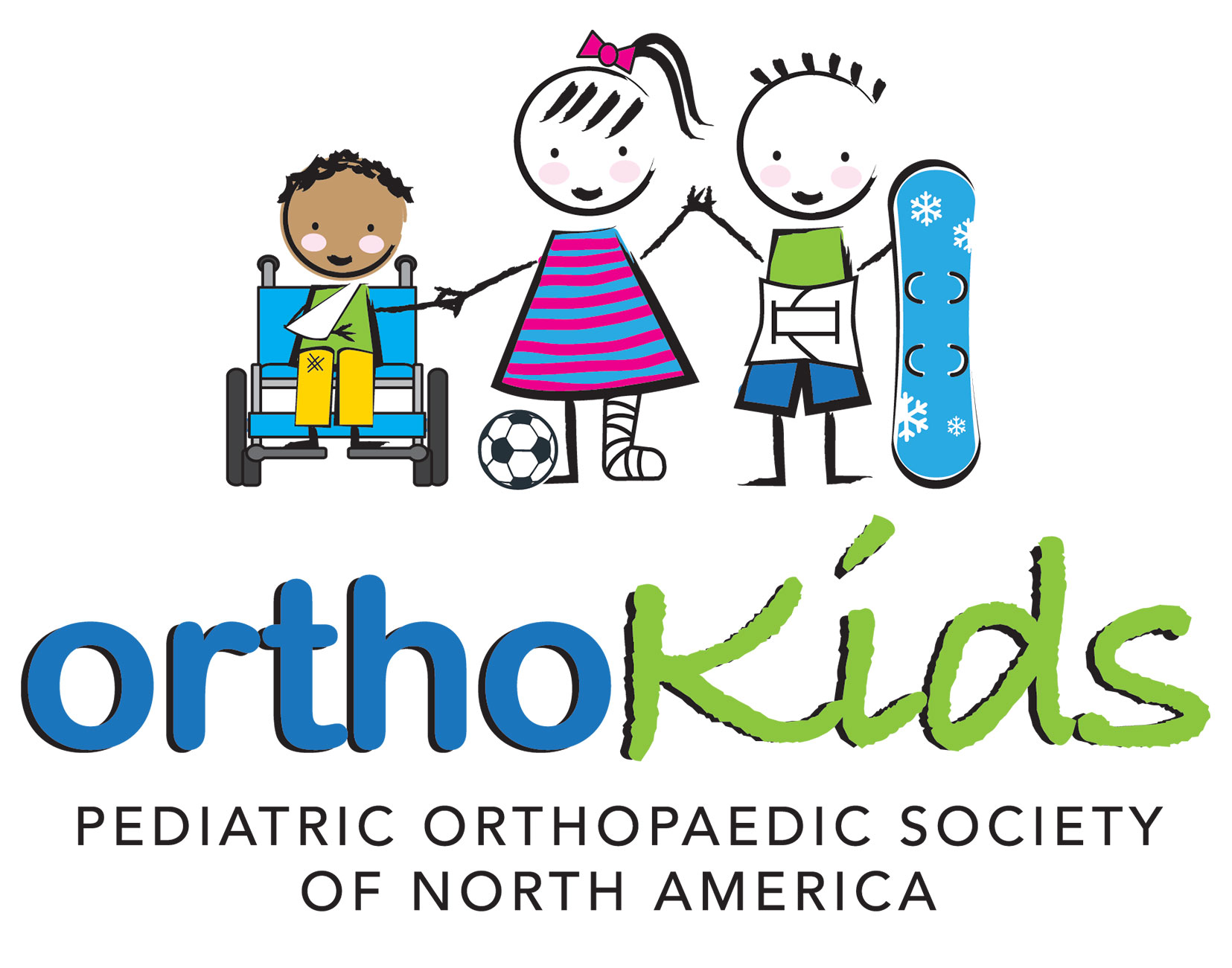Diseases & Conditions
Erb's Palsy
(Brachial Plexus Birth Palsy)
Erb's palsy is a form of brachial plexus palsy. It is named for one of the doctors who first described this condition, Wilhelm Erb.
The brachial plexus (BRAY-key-el PLEK-sis) is a network of nerves near the neck that give rise to all the nerves of the arm. These nerves provide movement and feeling to the shoulder, arm, hand, and fingers. Palsy means weakness, and brachial plexus birth palsy causes arm weakness and loss of motion.
One or 2 of every 1,000 babies sustain a brachial plexus birth palsy. It is often caused when an infant's neck is stretched to the side during a difficult delivery. It can be associated with high birth weight, maternal diabetes, and prolonged labor.
Most infants with brachial plexus birth palsy will recover both movement and feeling in the affected arm. Physical therapy is an important part of treatment. Parents/guardians play an active role in helping their child recover maximum function in the affected arm.
Anatomy
The brachial plexus is formed as the nerves to the arm, hand, and fingers pass from the spinal cord, between the bones of the neck (vertebrae), and into the arm.
This system of nerves then travels behind the collarbone (clavicle) and spreads out into the arm.
Description
In most cases of brachial plexus birth palsy, it is the upper nerves in the brachial plexus that are affected. This is known as Erb's palsy. The infant may not be able to move the shoulder but may be able to move the fingers. Other nerves may be affected in less common forms of brachial plexus birth palsy (Klumpke's palsy, total plexus palsy).
In general, there are four types of nerve injuries:
- Neurapraxia
- Neuroma
- Rupture
- Avulsion
All can occur at the same time in the same infant. The symptoms of all four types of nerve injury are the same (loss of feeling and partial or complete paralysis), but the potential for recovery is different. It is the severity of the injury that affects both treatment decisions and the amount of recovery possible.
Neurapraxia
A stretch injury that "shocks," but does not tear the nerve is the most common type. This is called a neurapraxia (nyur-ah-PRAK-see-ah).
Normally, these injuries heal on their own, usually within 3 months.
Neurapraxia can happen in adults, as well as infants. For example, when it happens to football players who are injured during play, it is called a "burner" or "stinger."
Neuroma
A stretch injury that damages some of the nerve fibers may result in scar tissue. The scar tissue may press on the remaining healthy nerve. This condition is called a neuroma.
Some, but not complete, recovery usually occurs.
Rupture
A stretch injury that causes the nerve to be torn apart (ruptured) will not heal on its own. A rupture happens when the nerve itself is torn.
It may be possible to repair a rupture by splicing (joining together) the damaged nerve with a nerve graft taken from another part of the child's body.
Avulsion
An avulsion happens when the nerve is torn from the spinal cord.
Unlike a nerve rupture, it is not possible to repair an avulsion from the spinal cord. In some cases, it may be possible to restore some function in the arm by using a nerve from another muscle as a donor and replacing the detached nerve.
Cause
Brachial plexus birth palsies in newborns may occur:
- During a difficult delivery, such as with a large baby, a breech presentation, or a prolonged labor.
- When a birth becomes complicated and the person assisting the delivery must deliver the baby quickly and exert some force to pull the baby from the birth canal. If one side of the baby's neck is stretched, the nerves may also be stretched, and injury may result.
However, brachial plexus birth palsy can occur in babies without any risk factors, as well as in babies delivered via Caesarean sections (C-sections).
Symptoms
Symptoms of brachial plexus birth palsy may include:
- Weakness in one arm
- Loss of feeling in the arm
- Partial or total paralysis of the arm
Doctor Examination
A pediatrician is usually the one to make the diagnosis of a brachial plexus birth palsy, based on weakness of the arm and physical examination.
Your child's doctor may order an X-ray, ultrasound, or other imaging test, such as a magnetic resonance imaging (MRI) scan, to learn whether there is any damage to the bones and joints of the neck and shoulder. The nerve injury can affect the growth and development of the shoulder.
The doctor may also do some tests to learn whether any nerve signals are present in the muscle of the upper arm. These tests may include an electromyogram (EMG) or a nerve conduction study (NCS).
Treatment
Because most newborns with brachial plexus birth palsy recover on their own, your child's doctor will re-examine your child frequently to see if the nerves are recovering. Nerves grow and recover very slowly; it may take up to 2 years for a complete recovery.
Nonsurgical Treatment
Daily physical therapy is the main treatment method for Erb's palsy.
Because a baby cannot move the affected arm all alone, parents must take an active role in keeping the joints limber and the functioning muscles fit. Your child's doctor or a physical therapist will teach you how to do exercises with your baby to keep your baby's arm in good condition.
Daily physical therapy and range-of-motion exercises, done as often as possible during the day, begin when a baby is about 3 weeks old. The exercises will maintain the range of motion in the shoulder, elbow, wrist, and hand. This will prevent the joint from becoming permanently stiff, a condition called joint contracture.
Surgical Treatment
If there is no change over the first 3 to 6 months, your child's doctor may suggest surgery on the nerves to improve the potential outcome.
Microsurgery
In microsurgery, surgeons often use high-powered microscopes and small, specialized instruments. Nerve surgery does not typically restore full, normal function, and it is usually not helpful for older infants.
- Nerve graft. Depending upon the nerve injury, it may be possible to repair a rupture. This is sometimes done by splicing (joining together) the damaged nerve with a nerve graft taken from another part of the child's body.
- Nerve transfer. In some cases, it may be possible to restore some function in the arm by using a nerve from another muscle as a donor.
Because nerves recover very slowly, it may take several months, or even years, for nerves repaired at the neck to reach the muscles of the lower arm and hand. After surgery, your child's doctor or physical therapist will provide rehabilitation exercises to perform at home to improve your baby's strength and range of motion.
Other Procedures
Other surgical options for treating brachial plexus birth palsy may include:
- Release of joint contractures. Stiff soft tissues around the shoulder and elbow joints can be released to allow more motion.
- Tendon transfer. To improve the ability to raise the arm, a functioning tendon is moved from its normal attachment in the body and reattached in the shoulder area.
- Reduction of joints. The thickened, stiff tissues around joints may cause the joint to come out of place, especially in the shoulder. Sometimes surgery is needed to put the joint back in place. This is called a reduction.
- Osteotomy. To optimize function, the surgeon realigns bones and joints in the affected limb
Outcomes
Many children with brachial plexus injuries will continue to have some weakness in the shoulder, arm, hand, or fingers. There may be other surgical procedures that can be performed in the future that might improve function. As your child grows, your doctor will discuss the various treatment options and make a specific recommendation based on your child's individual situation.
Living with Erb's Palsy
In some children, the affected arm is noticeably smaller than the unaffected arm. This occurs because nerves affect growth. Although the affected arm will continue to grow as the child grows, it grows at a slower pace, and the size difference will become more noticeable as the child gets older.
Children are very adaptable (able to adjust to change). Be supportive and encouraging and focus on all the things your child can do. This will help your child develop a healthy sense of self-esteem and make up for any limitations in function. Many children are able to lead productive lives, including participating in regular sports and activities, despite having a physical difference such as a brachial plexus birth palsy.
AAOS does not endorse any treatments, procedures, products, or physicians referenced herein. This information is provided as an educational service and is not intended to serve as medical advice. Anyone seeking specific orthopaedic advice or assistance should consult his or her orthopaedic surgeon, or locate one in your area through the AAOS Find an Orthopaedist program on this website.







